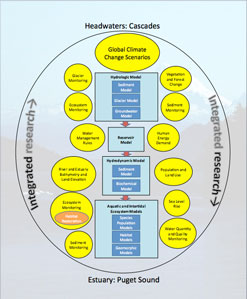SC2 Research Vision
The scientists of the Skagit Climate Science Consortium have expertise in many different aspects of climate change and how it affects components of the Skagit River system. Used to working with complex issues, these scientists began extending their scientific discourse outwards from their specific area of expertise to include other Skagit research scientists.
Since the 2009, they have realized that their research can more easily capture the complexities of climate change impacts and be more relevant to managers and policy makers if they use each other’s findings to develop, test, and model the components they are interested in. In this way, SC2 scientists are able to do INTEGRATED science, supporting their aspiration to build a model from the headwaters to the sound that will describe potential impacts of climate change on the Skagit. This research vision also serves as a tool to identify data gaps and to show how increased funding for critical research efforts contributes to information important to understanding potential climate impacts. By working together in this manner, SC2 research projects are stronger because they build on the results of others.
In order to visualize the complex relationships between components of the Skagit system that SC2 scientists are studying (for example, the relationship between melting glaciers, reservoir management for energy production, and the need for agricultural water supply downstream), the Consortium has developed a “research vision diagram.” The diagram shows what data and models are currently being used or are needed to better understand how climate change information at a global level moves through models from the headwaters in the Cascades to Puget Sound.
Along with global climate change information, more localized information on both the physical properties of the river and human needs or effects (like population size and land use change) is also entered into the models. The models themselves take inputs from either data collection efforts (i.e., sediment monitoring) or from other models (i.e., the reservoir model uses the hydrologic model’s outputs as inputs). Scientists then run a series of simulations based on known and/or hypothesized relationships. The models then produce outputs (i.e., predicted flood levels, flows, changes in vegetation, changes in sediment volume and location) that tell the scientists something about how the Skagit River system will behave under different scenarios of future change. These outputs are then tested with real data over time to improve the quality of the outputs.
In the diagram, the yellow bubbles represent information that is either collected by individual SC2 scientists, or is available for use from research being conducted by scientists outside SC2. This information is fed into the models depicted by the aqua rectangles. Each model in the series going from the top of the diagram to the bottom takes as inputs the outputs of the model above, and gives its outputs to the model below. Models shown in darker blue inside each of the aqua model rectangles are “sub-models,” which feed their inputs directly into the larger model but are not used outside that model. Similarly, orange bubbles shown inside the yellow bubbles depict data that is fed into the set of information being collected under a particular topic. In this way, all of the research being conducted under the SC2 vision is integrated across disciplines AND is designed to emulate the flow of water from headwaters to estuary.
The diagram is intended to capture SC2’s current research strategy as well as provide guidance for future research development. At present, not all models are fully developed, nor is all of the information depicted in the overall diagram being collected or utilized.

